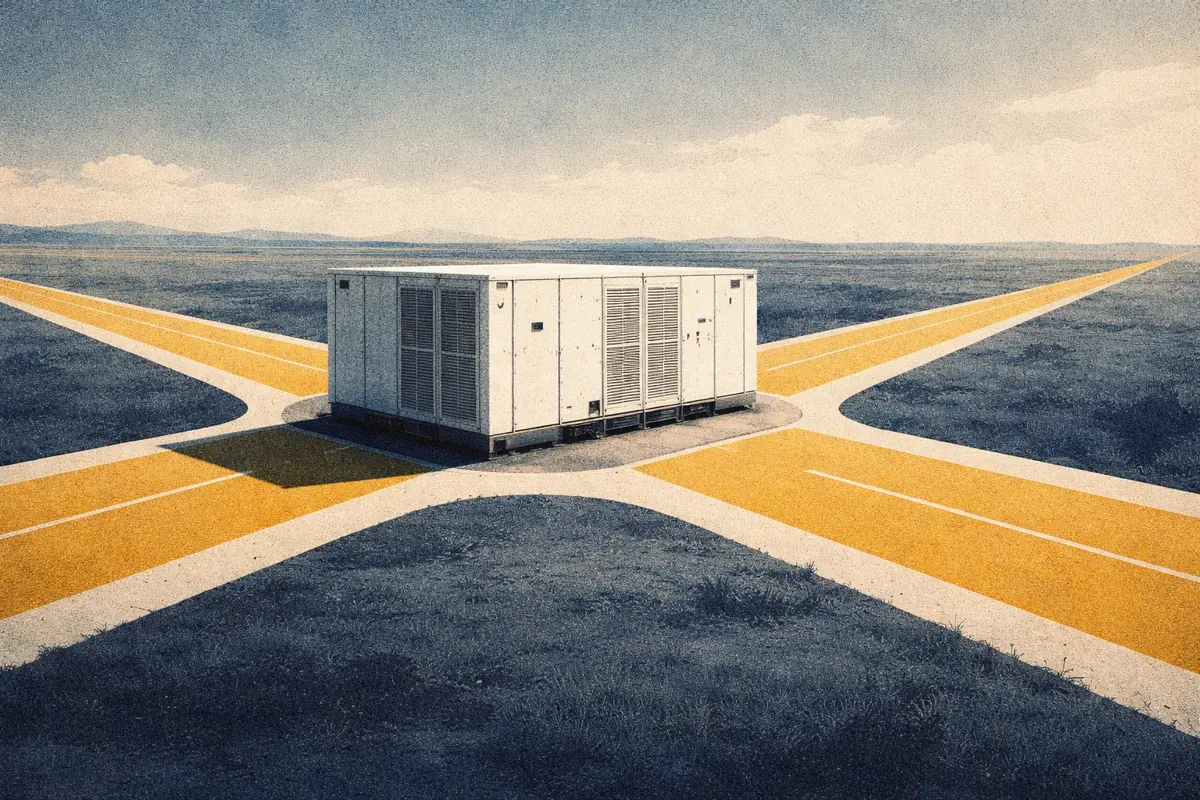Triads 2021/22: what were battery energy storage assets doing?
On the 29th March 2022, National Grid ESO announced the Triads for the 2021/22 winter period. In Figure 1 and Table 1 (both below), you can see when these three peaks fell.


(It’s worth noting here that only 6 MW separated the 2nd December peak from the 29th November. On top of this, none of the peaks fell during settlement period 36.)
In this article, we’ll look at:
- What Triads are.
- What battery energy storage systems (BESS) were doing in and around the 2021/22 Triad periods.
- And a breakdown of the respective operations of specific BESS assets at these times.
In the video below, Imrith and Neil discuss how batteries were operating during the 2021/22 Triad season:
What are Triads?
Triads are the three half-hour settlement periods with the highest demand on the transmission system, between November and February (inclusive), and separated by at least ten days on either side.

They provide a signal over the evening peak to reduce consumption (or increase generation/export, where applicable). They typically fall Monday - Thursday, between 17:00 and 18:00, when it’s particularly cold. It’s at these times - when demand is highest - that the transmission system is under the most stress.
Triads are used to decide Transmission Network Use of System (TNUoS) charges for half-hourly metered users of the transmission network - which largely means big industrial or commercial consumers of electricity, generators, and of course batteries. For these users, their TNUoS charge is calculated (in part) using their average consumption during the Triad periods.
TNUoS charges act as a strong price signal to half-hourly metered consumers to reduce their consumption across the winter evening peak (if they can) - particularly when demand elsewhere is very high. As such, trying to forecast when the Triads might fall can lead to significant cost savings, by avoiding high TNUoS costs. However, this makes the Triads inherently more difficult to predict. To put it simply, if everybody reduces their demand (or increases generation/export) at the same time because they think it’ll be a Triad, then another time will become the Triad instead.
What was battery energy storage doing during the Triads?
Embedded generation (i.e. distribution-connected assets) receives an export payment during Triads. The amount is based on two things:
- Average kW output during these periods; and
- an embedded export tariff, based on location (by grid supply point, or GSP).
These payments can be lucrative when Triads are guessed correctly. However, guess wrong and these assets run the risk of losing out on revenues through exiting frequency response services during these periods.
In this section, we look at how seventeen assets (making up a cumulative 588.5 MW of capacity) helped ease demand in and around the Triad periods. We’ve narrowed our selection down to Balancing Mechanism-registered assets only.
First Triad: 2nd December 2021
Figure 3 (below) shows the operational profile of these assets, collectively, across the first Triad on the 2nd December 2021.

- Peak BESS export missed the Triad by a settlement period. We can see that the majority of BESS optimisers assumed that the Triad would fall in settlement period 35 or 36 (as has historically been typical), and exported accordingly.
- However, the Triad actually ended up being settlement period 34 (16:30-17:00). BESS assets exported at just 19.45 MW (cumulatively) during the Triad. This was provided by four assets (Contego, Creyke Beck, Pelham, and Roundponds), 12% of their cumulative rated capacity.
Non-Triad: 29th November 2021
As mentioned previously, just 6 MW separated the peak on 2nd December (the actual Triad) and that on 29th November. Figure 4 (below) highlights how many assets expected this to be a Triad, with BESS exporting at a net 302 MW during settlement period 35. Had BESS exported 7 MW less (less than 3% of the total BESS export) - pushing total system demand up by 7 MW during settlement period 35 - this would have been the first Triad of the season. And those BESS exporting during this period would have seen significantly higher TNUoS revenues.

Second Triad: 5th January 2022
Figure 5 (below) shows the operational profile of these assets, collectively, across the second Triad on the 5th January 2022.

- During January, BESS FFR participation was much higher than in December. 42.4% (250 MW) of the capacity of our selected BESS assets provided the service in EFA 5 (15:00-19:00) across January. In December, this was 0%.
- For the second Triad, we saw a much higher success rate among available BESS assets - i.e. those not participating in FFR, and therefore available to export during the Triad. 92% of available BESS capacity exported at this time.
The third Triad (20th January) had a very similar profile to the second.
BESS asset breakdown
Triads case study: Minety (20th January)
Figure 6 (below) shows the operational profile of the Minety battery on the 20th January - the day of the third Triad.

Let’s see what Minety was doing in each EFA block of that day:
- Symmetric participation in DC high- and low-frequency (82 MW) to maximise revenues.
- Importing to manage state of charge, in preparation for the evening peak/potential Triad.
- Asymmetric DC participation, providing more DCH than DCL.
- Asymmetric DC participation, providing more DCH than DCL. (Albeit at lower volumes than during EFA 3, to enable export at maximum capacity during the evening Triad.)
- Exporting across peak (eventual Triad) period.
- Importing to rebalance state of charge, to enable DC delivery in the following EFA block.
Ranking BESS assets by Triads success rate
Table 2 (below) details the operation and subsequent receivable TNUoS of the seventeen BMU assets we have looked at in this section. We have ranked these assets by the proportion of their rated power (MW) that they exported, on average, during the Triad periods. (This is labelled as ‘Normalised capacity’ in Table 2.)

Figure 7 (below) shows a summary of how these assets performed on the Modo Leaderboard during the Triad months, with the addition of receivable TNUoS during this time period.

- Contego had both the highest Triad normalised export capacity and the highest revenues over this period. Receivable TNUoS accounted for 6% of its total revenues.
- Receivable TNUoS made up the highest proportion of Hill Farm’s revenues than any other asset - 9.64%.
- Across this period, receivable TNUoS was more lucrative for BESS assets than Balancing Mechanism participation.
- In total assets earned £23,345/MW from receivable TNUoS, representing 2.77% of total revenues between all seventeen assets during this period.
Some final thoughts
When guessed correctly, Triads provide a welcome opportunity for battery energy storage owners to boost their winter revenue stack. That said, as outlined by the timing of the 2nd December Triad, they are increasingly unpredictable. All of this adds another level of complexity to the operation of BESS assets during the winter months.
Optimisers already have to manage their asset’s state of charge, decide when or whether to provide frequency response, as well as figure out whether to do this symmetrically or not. The outcomes of these decisions will impact an asset’s ability to take advantage of TNUoS export charges.
With the looming implementation of Ofgem’s Targeted Charging Review suggestions, however, we expect 2022/23 to be the last winter of Triads - at least for the residual part of the TNUoS charge. From April 2023, this will come from fixed charges for all households and businesses. The locational part of the tariff will remain in some areas. While this will mean one less potential revenue booster for batteries, the costs of maintaining the transmission should be more fairly distributed among those that use it.







